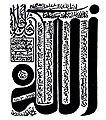|
Muhammad bin Al-Qasim al-Qundusi
Muhammad Bin Al-Qāsim al-Qundūsi ( Arabic: محمد بن القاسم القندوسي; born c. 1790 – died 1861) was an Algerian Sufi calligrapher and scholar who was born in Qanaadasa in southwest Algeria. Biography Al-Qundusi was born in Qanaadasa in 1790 in southwest Algeria.[1][2] In 1828, he migrated to Fes, where he lived and had a hanout in the herb market, in which he sold herbs.[3] He lived in relative obscurity, though those who knew him described him as gnostic, saintly, esoterically knowledgeable, and spiritually insightful.[4] He wrote many books and transcribed a number of dawawin, or collected works. He conferred upon the Moroccan Alawite Sultan Sliman a degree in knowledge of the Dala'il al-Khayrat, a seminal Sufi text composed by the 15th-century Muhammad al-Jazuli.[5] al-Qundusi passed away in 1861.[2][6] He was a Sufi associated with the Qadiri and Nasiri orders.[7] CalligraphyHe was a talented calligrapher, specializing in a flamboyant style of the Maghrebi script that he innovated. He also created a copy of the Quran in 12 volumes which he finished on September 7–8, 1850, and which is kept in al-Khizāna al-Ḥassania.[8] He drew the name of Allah in the Zawiya of Idriss II in Fes.[9]
WorksHis works include:
LegacyMost of his works are now kept at the national library in Rabat.[14] His works inspired a typeface called Qandus,[15] which was designed by Kristyan Sarkis of TPTQ Arabic, and won the Type Directors Club's 2017 Typeface Design Award.[16] References
|
||||||||||||




